Constitutional Law Report: Australian Migration Law and Asylum Seekers
VerifiedAdded on 2020/04/01
|6
|1242
|95
Report
AI Summary
This report provides an analysis of the Australian constitutional law concerning migration, with a specific focus on the Migration Legislation Amendment Act 2017. The report examines the powers of the Commonwealth regarding migration laws, executive powers in maintaining and executing these laws, and the implications of compulsory detention for asylum seekers arriving by boat. The report critically assesses the proposed electronic fence and its human rights implications, particularly in the context of the case of Khushal Chakrabarty and his family. It argues that the authorities should reconsider the rule and amend it so as to put into consideration special circumstances that may hinder one from adhering to the rules. Additionally, it discusses the legal status of individuals born in Australia to non-citizens, referencing Singh v Commonwealth (2004). The report concludes by criticizing the biased nature of the Commonwealth laws and proposes more effective solutions that distinguish genuine asylum seekers from individuals with ill motives. It emphasizes the importance of upholding human rights and the principles outlined in Chu Kheng Lim concerning the detention of civilians.
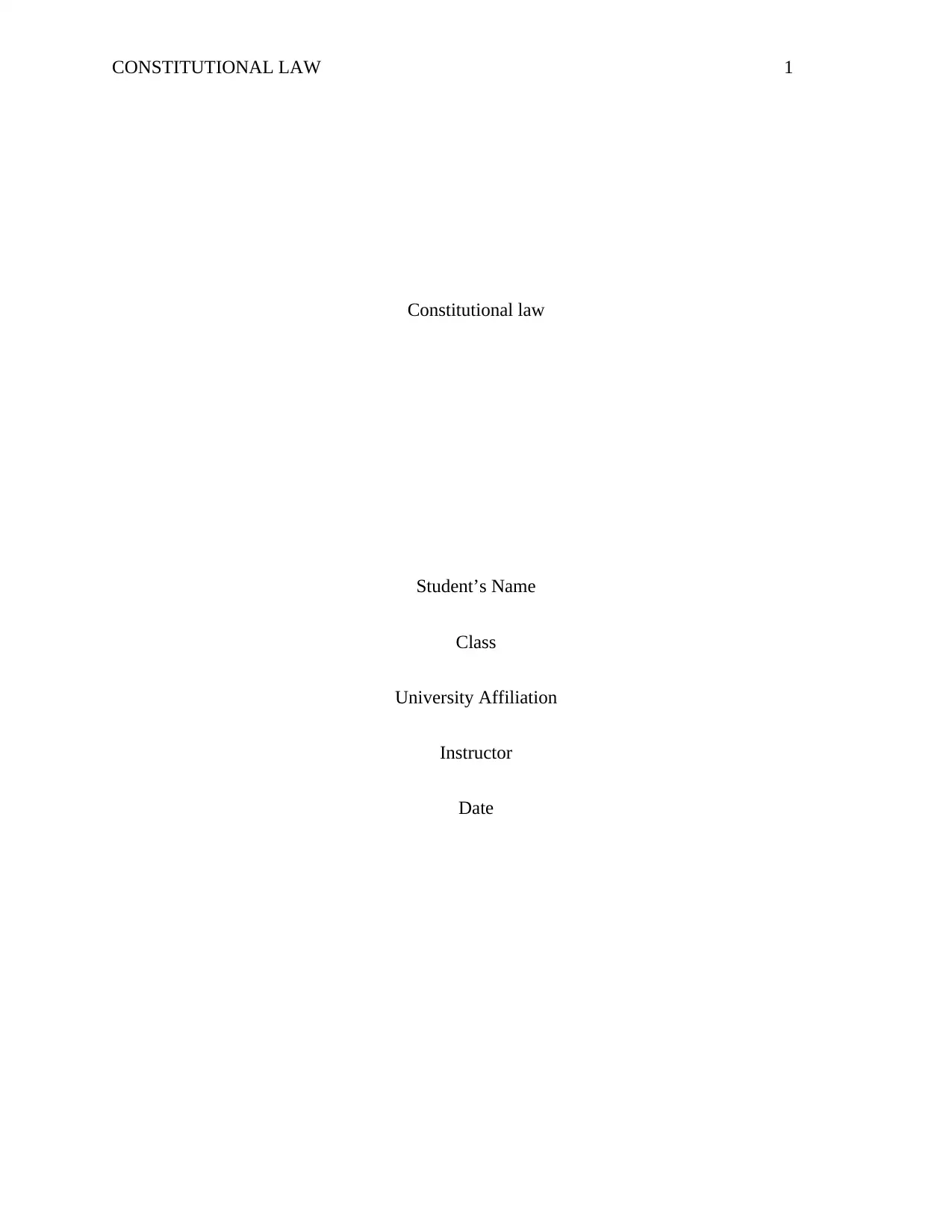
CONSTITUTIONAL LAW 1
Constitutional law
Student’s Name
Class
University Affiliation
Instructor
Date
Constitutional law
Student’s Name
Class
University Affiliation
Instructor
Date
Paraphrase This Document
Need a fresh take? Get an instant paraphrase of this document with our AI Paraphraser
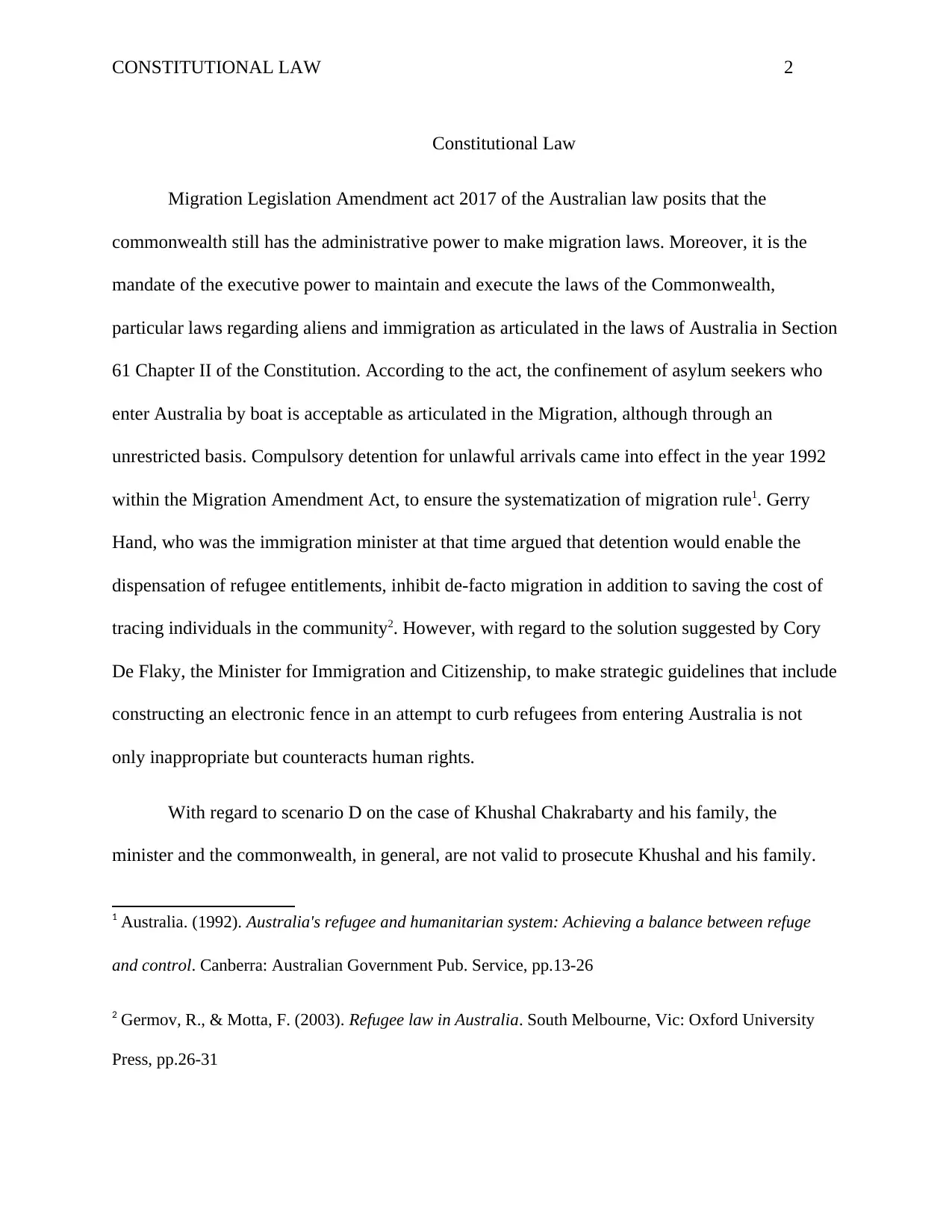
CONSTITUTIONAL LAW 2
Constitutional Law
Migration Legislation Amendment act 2017 of the Australian law posits that the
commonwealth still has the administrative power to make migration laws. Moreover, it is the
mandate of the executive power to maintain and execute the laws of the Commonwealth,
particular laws regarding aliens and immigration as articulated in the laws of Australia in Section
61 Chapter II of the Constitution. According to the act, the confinement of asylum seekers who
enter Australia by boat is acceptable as articulated in the Migration, although through an
unrestricted basis. Compulsory detention for unlawful arrivals came into effect in the year 1992
within the Migration Amendment Act, to ensure the systematization of migration rule1. Gerry
Hand, who was the immigration minister at that time argued that detention would enable the
dispensation of refugee entitlements, inhibit de-facto migration in addition to saving the cost of
tracing individuals in the community2. However, with regard to the solution suggested by Cory
De Flaky, the Minister for Immigration and Citizenship, to make strategic guidelines that include
constructing an electronic fence in an attempt to curb refugees from entering Australia is not
only inappropriate but counteracts human rights.
With regard to scenario D on the case of Khushal Chakrabarty and his family, the
minister and the commonwealth, in general, are not valid to prosecute Khushal and his family.
1 Australia. (1992). Australia's refugee and humanitarian system: Achieving a balance between refuge
and control. Canberra: Australian Government Pub. Service, pp.13-26
2 Germov, R., & Motta, F. (2003). Refugee law in Australia. South Melbourne, Vic: Oxford University
Press, pp.26-31
Constitutional Law
Migration Legislation Amendment act 2017 of the Australian law posits that the
commonwealth still has the administrative power to make migration laws. Moreover, it is the
mandate of the executive power to maintain and execute the laws of the Commonwealth,
particular laws regarding aliens and immigration as articulated in the laws of Australia in Section
61 Chapter II of the Constitution. According to the act, the confinement of asylum seekers who
enter Australia by boat is acceptable as articulated in the Migration, although through an
unrestricted basis. Compulsory detention for unlawful arrivals came into effect in the year 1992
within the Migration Amendment Act, to ensure the systematization of migration rule1. Gerry
Hand, who was the immigration minister at that time argued that detention would enable the
dispensation of refugee entitlements, inhibit de-facto migration in addition to saving the cost of
tracing individuals in the community2. However, with regard to the solution suggested by Cory
De Flaky, the Minister for Immigration and Citizenship, to make strategic guidelines that include
constructing an electronic fence in an attempt to curb refugees from entering Australia is not
only inappropriate but counteracts human rights.
With regard to scenario D on the case of Khushal Chakrabarty and his family, the
minister and the commonwealth, in general, are not valid to prosecute Khushal and his family.
1 Australia. (1992). Australia's refugee and humanitarian system: Achieving a balance between refuge
and control. Canberra: Australian Government Pub. Service, pp.13-26
2 Germov, R., & Motta, F. (2003). Refugee law in Australia. South Melbourne, Vic: Oxford University
Press, pp.26-31
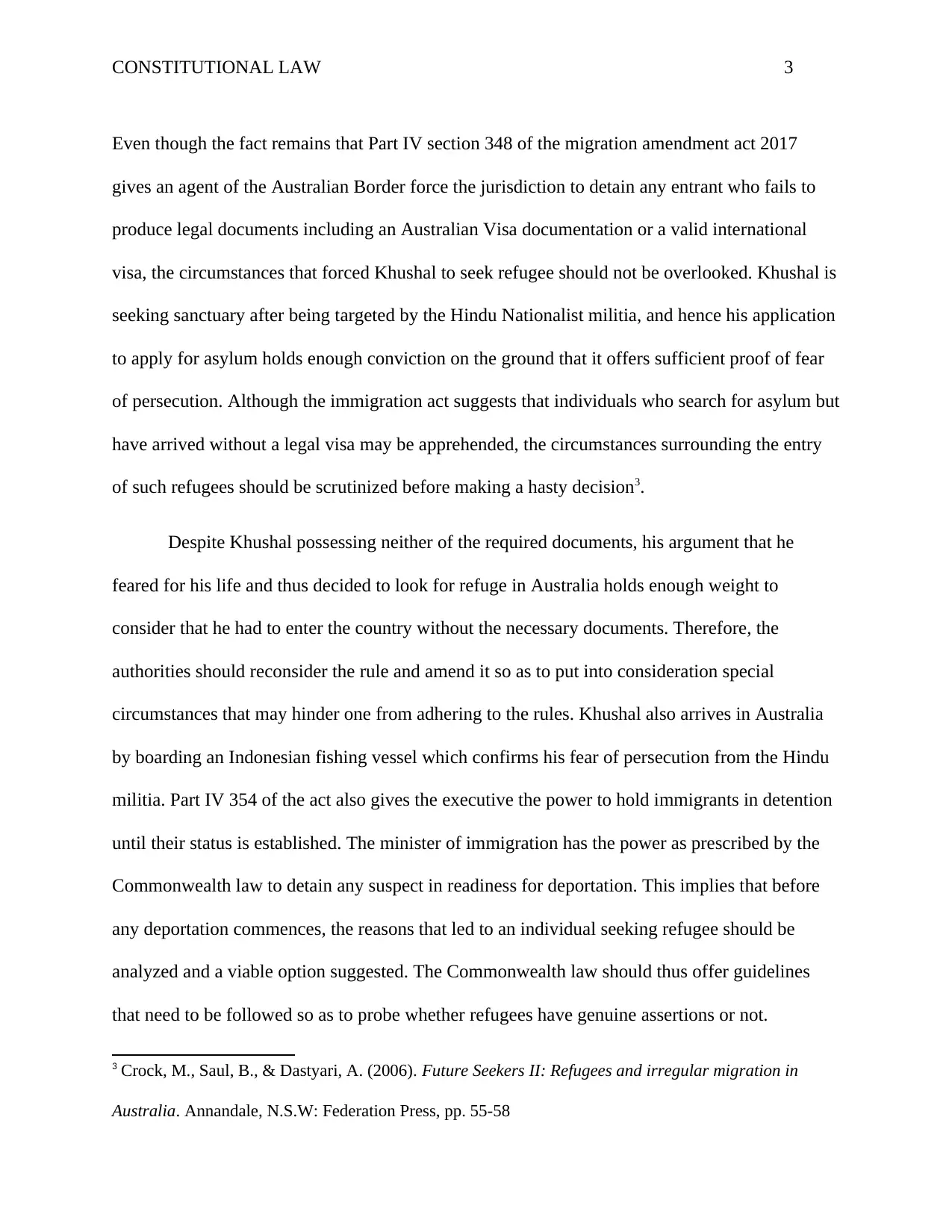
CONSTITUTIONAL LAW 3
Even though the fact remains that Part IV section 348 of the migration amendment act 2017
gives an agent of the Australian Border force the jurisdiction to detain any entrant who fails to
produce legal documents including an Australian Visa documentation or a valid international
visa, the circumstances that forced Khushal to seek refugee should not be overlooked. Khushal is
seeking sanctuary after being targeted by the Hindu Nationalist militia, and hence his application
to apply for asylum holds enough conviction on the ground that it offers sufficient proof of fear
of persecution. Although the immigration act suggests that individuals who search for asylum but
have arrived without a legal visa may be apprehended, the circumstances surrounding the entry
of such refugees should be scrutinized before making a hasty decision3.
Despite Khushal possessing neither of the required documents, his argument that he
feared for his life and thus decided to look for refuge in Australia holds enough weight to
consider that he had to enter the country without the necessary documents. Therefore, the
authorities should reconsider the rule and amend it so as to put into consideration special
circumstances that may hinder one from adhering to the rules. Khushal also arrives in Australia
by boarding an Indonesian fishing vessel which confirms his fear of persecution from the Hindu
militia. Part IV 354 of the act also gives the executive the power to hold immigrants in detention
until their status is established. The minister of immigration has the power as prescribed by the
Commonwealth law to detain any suspect in readiness for deportation. This implies that before
any deportation commences, the reasons that led to an individual seeking refugee should be
analyzed and a viable option suggested. The Commonwealth law should thus offer guidelines
that need to be followed so as to probe whether refugees have genuine assertions or not.
3 Crock, M., Saul, B., & Dastyari, A. (2006). Future Seekers II: Refugees and irregular migration in
Australia. Annandale, N.S.W: Federation Press, pp. 55-58
Even though the fact remains that Part IV section 348 of the migration amendment act 2017
gives an agent of the Australian Border force the jurisdiction to detain any entrant who fails to
produce legal documents including an Australian Visa documentation or a valid international
visa, the circumstances that forced Khushal to seek refugee should not be overlooked. Khushal is
seeking sanctuary after being targeted by the Hindu Nationalist militia, and hence his application
to apply for asylum holds enough conviction on the ground that it offers sufficient proof of fear
of persecution. Although the immigration act suggests that individuals who search for asylum but
have arrived without a legal visa may be apprehended, the circumstances surrounding the entry
of such refugees should be scrutinized before making a hasty decision3.
Despite Khushal possessing neither of the required documents, his argument that he
feared for his life and thus decided to look for refuge in Australia holds enough weight to
consider that he had to enter the country without the necessary documents. Therefore, the
authorities should reconsider the rule and amend it so as to put into consideration special
circumstances that may hinder one from adhering to the rules. Khushal also arrives in Australia
by boarding an Indonesian fishing vessel which confirms his fear of persecution from the Hindu
militia. Part IV 354 of the act also gives the executive the power to hold immigrants in detention
until their status is established. The minister of immigration has the power as prescribed by the
Commonwealth law to detain any suspect in readiness for deportation. This implies that before
any deportation commences, the reasons that led to an individual seeking refugee should be
analyzed and a viable option suggested. The Commonwealth law should thus offer guidelines
that need to be followed so as to probe whether refugees have genuine assertions or not.
3 Crock, M., Saul, B., & Dastyari, A. (2006). Future Seekers II: Refugees and irregular migration in
Australia. Annandale, N.S.W: Federation Press, pp. 55-58
⊘ This is a preview!⊘
Do you want full access?
Subscribe today to unlock all pages.

Trusted by 1+ million students worldwide
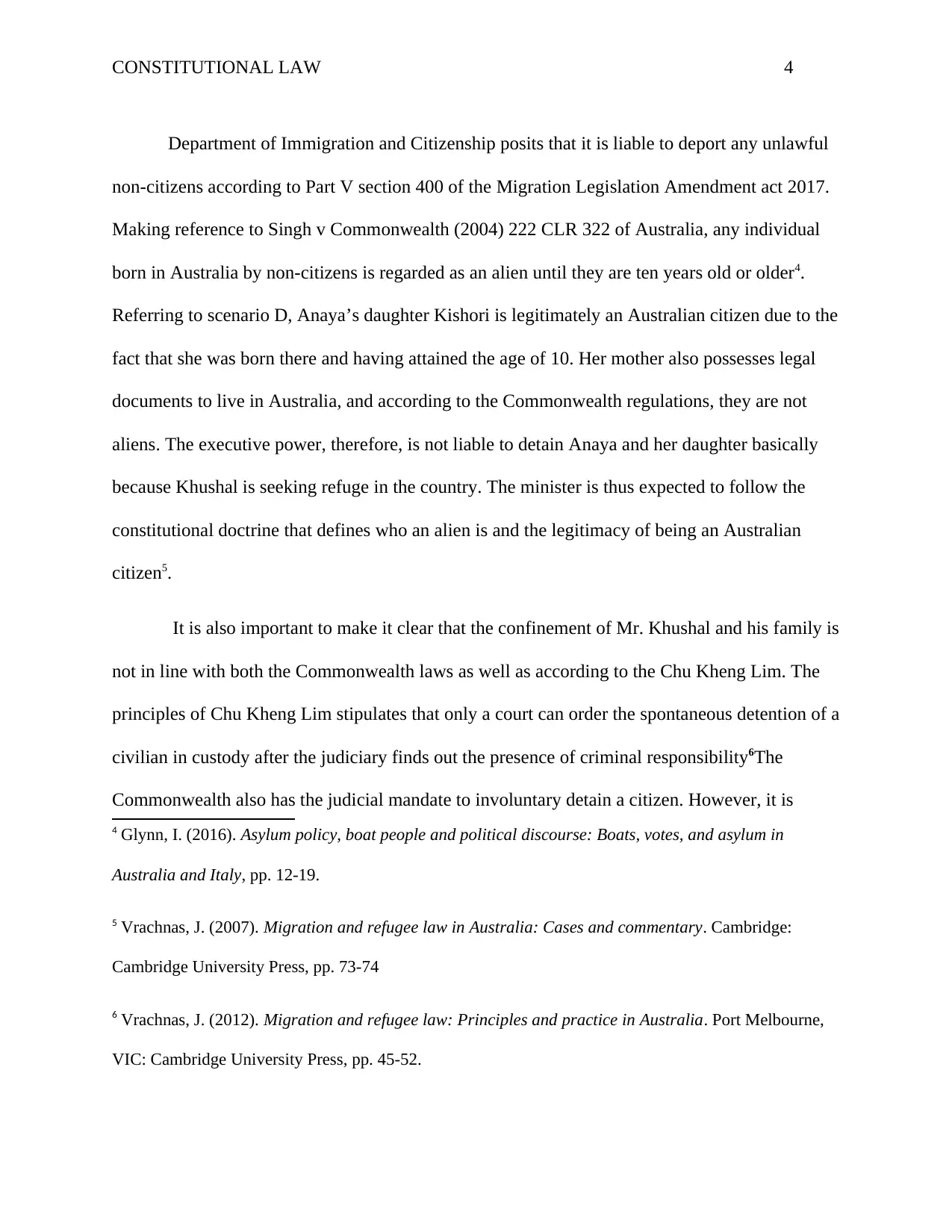
CONSTITUTIONAL LAW 4
Department of Immigration and Citizenship posits that it is liable to deport any unlawful
non-citizens according to Part V section 400 of the Migration Legislation Amendment act 2017.
Making reference to Singh v Commonwealth (2004) 222 CLR 322 of Australia, any individual
born in Australia by non-citizens is regarded as an alien until they are ten years old or older4.
Referring to scenario D, Anaya’s daughter Kishori is legitimately an Australian citizen due to the
fact that she was born there and having attained the age of 10. Her mother also possesses legal
documents to live in Australia, and according to the Commonwealth regulations, they are not
aliens. The executive power, therefore, is not liable to detain Anaya and her daughter basically
because Khushal is seeking refuge in the country. The minister is thus expected to follow the
constitutional doctrine that defines who an alien is and the legitimacy of being an Australian
citizen5.
It is also important to make it clear that the confinement of Mr. Khushal and his family is
not in line with both the Commonwealth laws as well as according to the Chu Kheng Lim. The
principles of Chu Kheng Lim stipulates that only a court can order the spontaneous detention of a
civilian in custody after the judiciary finds out the presence of criminal responsibility6The
Commonwealth also has the judicial mandate to involuntary detain a citizen. However, it is
4 Glynn, I. (2016). Asylum policy, boat people and political discourse: Boats, votes, and asylum in
Australia and Italy, pp. 12-19.
5 Vrachnas, J. (2007). Migration and refugee law in Australia: Cases and commentary. Cambridge:
Cambridge University Press, pp. 73-74
6 Vrachnas, J. (2012). Migration and refugee law: Principles and practice in Australia. Port Melbourne,
VIC: Cambridge University Press, pp. 45-52.
Department of Immigration and Citizenship posits that it is liable to deport any unlawful
non-citizens according to Part V section 400 of the Migration Legislation Amendment act 2017.
Making reference to Singh v Commonwealth (2004) 222 CLR 322 of Australia, any individual
born in Australia by non-citizens is regarded as an alien until they are ten years old or older4.
Referring to scenario D, Anaya’s daughter Kishori is legitimately an Australian citizen due to the
fact that she was born there and having attained the age of 10. Her mother also possesses legal
documents to live in Australia, and according to the Commonwealth regulations, they are not
aliens. The executive power, therefore, is not liable to detain Anaya and her daughter basically
because Khushal is seeking refuge in the country. The minister is thus expected to follow the
constitutional doctrine that defines who an alien is and the legitimacy of being an Australian
citizen5.
It is also important to make it clear that the confinement of Mr. Khushal and his family is
not in line with both the Commonwealth laws as well as according to the Chu Kheng Lim. The
principles of Chu Kheng Lim stipulates that only a court can order the spontaneous detention of a
civilian in custody after the judiciary finds out the presence of criminal responsibility6The
Commonwealth also has the judicial mandate to involuntary detain a citizen. However, it is
4 Glynn, I. (2016). Asylum policy, boat people and political discourse: Boats, votes, and asylum in
Australia and Italy, pp. 12-19.
5 Vrachnas, J. (2007). Migration and refugee law in Australia: Cases and commentary. Cambridge:
Cambridge University Press, pp. 73-74
6 Vrachnas, J. (2012). Migration and refugee law: Principles and practice in Australia. Port Melbourne,
VIC: Cambridge University Press, pp. 45-52.
Paraphrase This Document
Need a fresh take? Get an instant paraphrase of this document with our AI Paraphraser
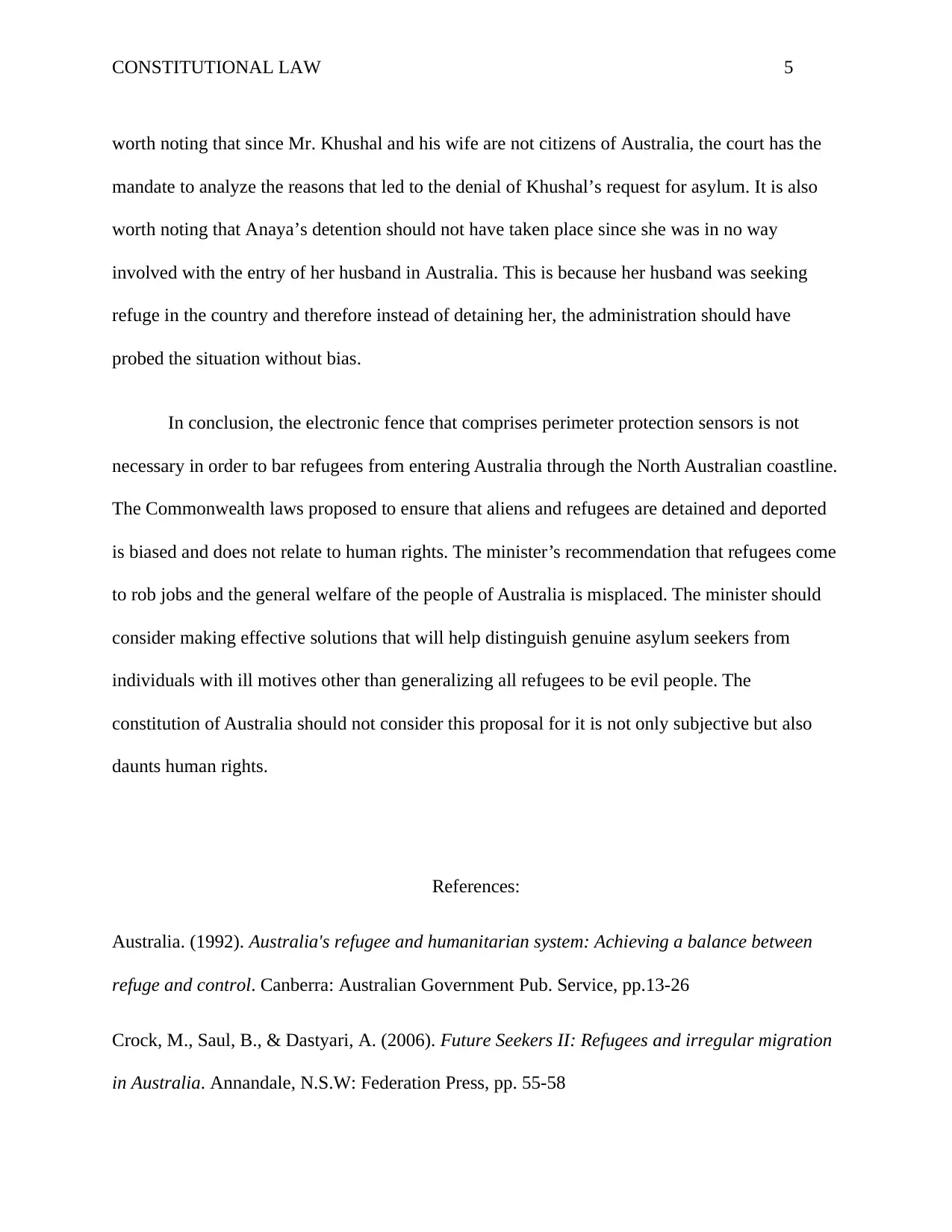
CONSTITUTIONAL LAW 5
worth noting that since Mr. Khushal and his wife are not citizens of Australia, the court has the
mandate to analyze the reasons that led to the denial of Khushal’s request for asylum. It is also
worth noting that Anaya’s detention should not have taken place since she was in no way
involved with the entry of her husband in Australia. This is because her husband was seeking
refuge in the country and therefore instead of detaining her, the administration should have
probed the situation without bias.
In conclusion, the electronic fence that comprises perimeter protection sensors is not
necessary in order to bar refugees from entering Australia through the North Australian coastline.
The Commonwealth laws proposed to ensure that aliens and refugees are detained and deported
is biased and does not relate to human rights. The minister’s recommendation that refugees come
to rob jobs and the general welfare of the people of Australia is misplaced. The minister should
consider making effective solutions that will help distinguish genuine asylum seekers from
individuals with ill motives other than generalizing all refugees to be evil people. The
constitution of Australia should not consider this proposal for it is not only subjective but also
daunts human rights.
References:
Australia. (1992). Australia's refugee and humanitarian system: Achieving a balance between
refuge and control. Canberra: Australian Government Pub. Service, pp.13-26
Crock, M., Saul, B., & Dastyari, A. (2006). Future Seekers II: Refugees and irregular migration
in Australia. Annandale, N.S.W: Federation Press, pp. 55-58
worth noting that since Mr. Khushal and his wife are not citizens of Australia, the court has the
mandate to analyze the reasons that led to the denial of Khushal’s request for asylum. It is also
worth noting that Anaya’s detention should not have taken place since she was in no way
involved with the entry of her husband in Australia. This is because her husband was seeking
refuge in the country and therefore instead of detaining her, the administration should have
probed the situation without bias.
In conclusion, the electronic fence that comprises perimeter protection sensors is not
necessary in order to bar refugees from entering Australia through the North Australian coastline.
The Commonwealth laws proposed to ensure that aliens and refugees are detained and deported
is biased and does not relate to human rights. The minister’s recommendation that refugees come
to rob jobs and the general welfare of the people of Australia is misplaced. The minister should
consider making effective solutions that will help distinguish genuine asylum seekers from
individuals with ill motives other than generalizing all refugees to be evil people. The
constitution of Australia should not consider this proposal for it is not only subjective but also
daunts human rights.
References:
Australia. (1992). Australia's refugee and humanitarian system: Achieving a balance between
refuge and control. Canberra: Australian Government Pub. Service, pp.13-26
Crock, M., Saul, B., & Dastyari, A. (2006). Future Seekers II: Refugees and irregular migration
in Australia. Annandale, N.S.W: Federation Press, pp. 55-58
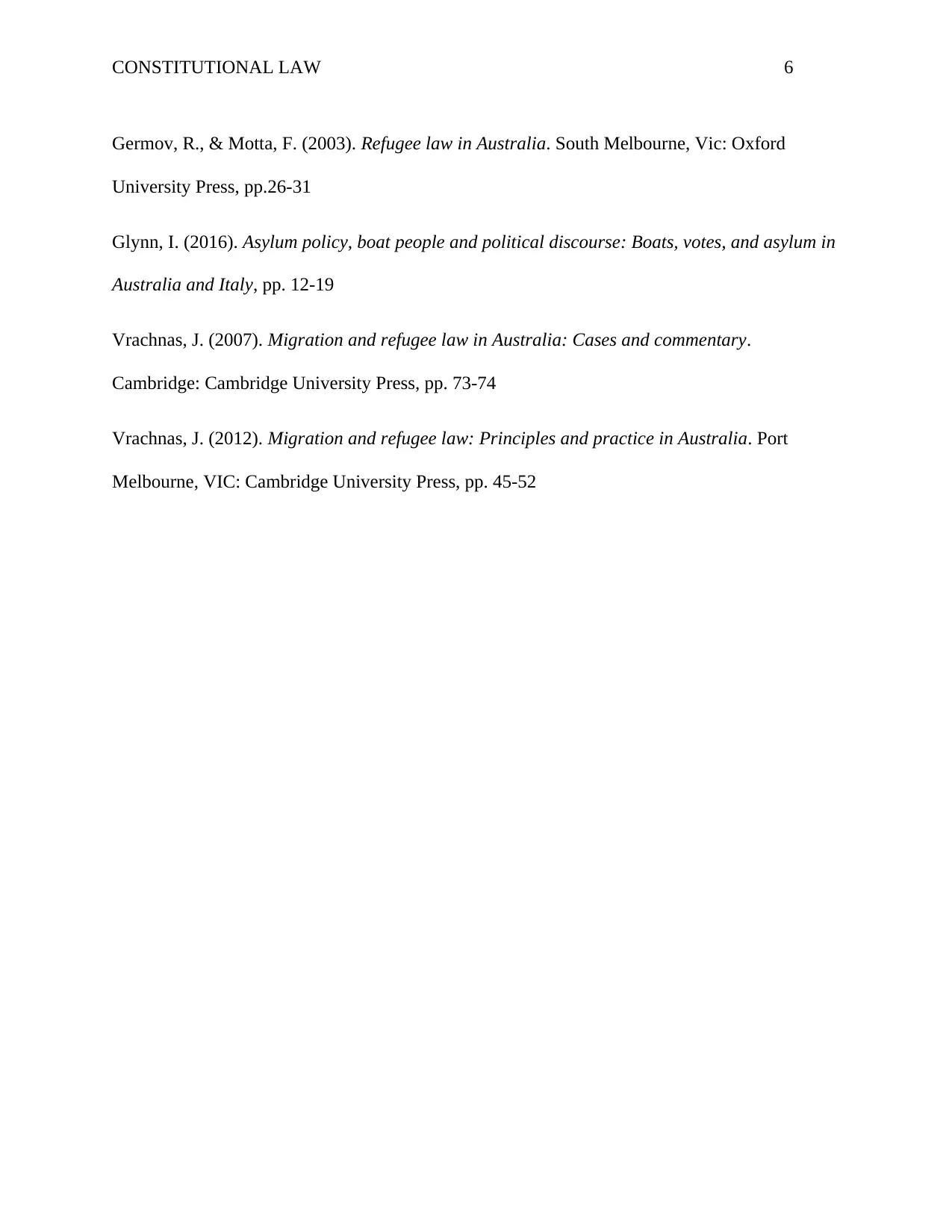
CONSTITUTIONAL LAW 6
Germov, R., & Motta, F. (2003). Refugee law in Australia. South Melbourne, Vic: Oxford
University Press, pp.26-31
Glynn, I. (2016). Asylum policy, boat people and political discourse: Boats, votes, and asylum in
Australia and Italy, pp. 12-19
Vrachnas, J. (2007). Migration and refugee law in Australia: Cases and commentary.
Cambridge: Cambridge University Press, pp. 73-74
Vrachnas, J. (2012). Migration and refugee law: Principles and practice in Australia. Port
Melbourne, VIC: Cambridge University Press, pp. 45-52
Germov, R., & Motta, F. (2003). Refugee law in Australia. South Melbourne, Vic: Oxford
University Press, pp.26-31
Glynn, I. (2016). Asylum policy, boat people and political discourse: Boats, votes, and asylum in
Australia and Italy, pp. 12-19
Vrachnas, J. (2007). Migration and refugee law in Australia: Cases and commentary.
Cambridge: Cambridge University Press, pp. 73-74
Vrachnas, J. (2012). Migration and refugee law: Principles and practice in Australia. Port
Melbourne, VIC: Cambridge University Press, pp. 45-52
⊘ This is a preview!⊘
Do you want full access?
Subscribe today to unlock all pages.

Trusted by 1+ million students worldwide
1 out of 6
Related Documents
Your All-in-One AI-Powered Toolkit for Academic Success.
+13062052269
info@desklib.com
Available 24*7 on WhatsApp / Email
![[object Object]](/_next/static/media/star-bottom.7253800d.svg)
Unlock your academic potential
Copyright © 2020–2025 A2Z Services. All Rights Reserved. Developed and managed by ZUCOL.





